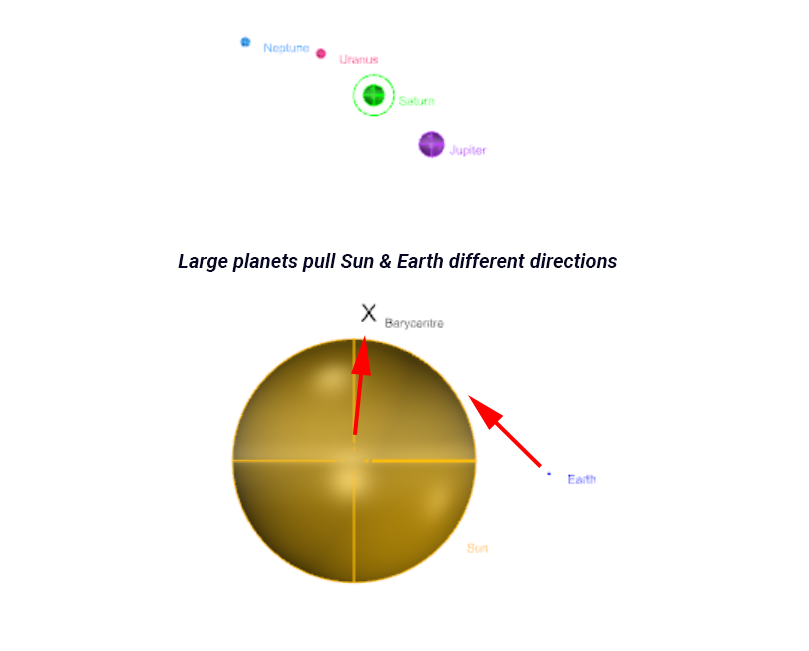Reasons Irrational:
The editors of Science retracted Valentina Zharkova’s paper, which can be viewed in its original form here.
The paper is significant because it shows that the influence of the larger planets on the distance between the Earth and the Sun is not negligible. That means this distance changes, effecting Earth’s climate.
It appears to have been retracted because it challenges the consensus of the climate “science being settled”. Again, science is never settled. This paper presents new understandings, and probably embarrassed NASA, undermining their public commitment to global warming. The Science journal retraction notice referenced a software technology for calculating orbits optimized for VT100 terminals, state-of-the-art in 1978!
The Editor of Science explains: “The analyses presented in the section entitled “Effects of SIM on a temperature in the terrestrial hemispheres” are based on the assumption that the orbits of the Earth and the Sun about the Solar System barycentre are uncorrelated, so that the Earth-Sun distance changes by an amount comparable to the Sun-barycentre distance.”
Yet the orbits are uncorrelated: they are affected by the larger planets, which revolve around the barycentre themselves at their own, historically-established pace, largely arbitrary from a correlation standpoint. Furthermore, the Sun revolves around the solar system barycentre once every ~12 years, to 1 year for Earth, while the distance from Jupiter to the Sun, 750m km, is ~5Xs that of the Earth to the Sun, 150m km. Saturn, on the other hand, is about ~10Xs that of the Earth’s radius of revolution about the barycentre, or about 1.5b km. These other planet orbits are within a magnitude of one another, exerting substantial influence upon the orbit of the Earth, depending on their relative locations, but again, that is uncorrelated to the Sun-Earth distance, which changes.
Thus, the Earth’s distance to the Sun does indeed change from the influence of the other planets, and thus will have a substantial effect upon the solar irradiance of the Earth, which can be calculated for different positions to verify that.
Yet, Science says that “Post-publication peer review has shown that this assumption is inaccurate because the motions of the Earth and the Sun are primarily due to Jupiter and the other giant planets, which accelerate the Earth and the Sun in nearly the same direction, and thereby generate highly-correlated motions in the Earth and Sun.”
Because the barycentre is at the centre of both the Sun and the Earth orbits, and both orbit that centre at different rates, the acceleration vector of each is always pointing to the barycentre. In this case the editor and peer reviews are blatantly incorrect. At all times, except when the sun and earth are aligned with one another on rare occasion with respect to the barycentre, the two acceleration vectors are in different directions. The sketches below show (roughly) that the planets affect the revolutions of the Sun and Earth rarely aligned, in the first sketch (planet sizes to scale, but not distances from the barycentre):

…and then have accelerations opposed to one another, in the second sketch below:

These sketches are not to scale, but make clear enough the effects of the moving larger planets on the Earth and the Sun. The retraction makes no sense—have the editors been pressured to conform to the consensus?
The barycentre is the center of gravity of the solar system. It is constantly moving through the Milky Way Galaxy, and wobbles relative to each of the planets, the larger ones more than the smaller. It is located slightly outside of the Sun’s radius.
What are your thoughts? Should it have been retracted? Are the Science Editor’s reasons adequate, or have they bowed to political pressure? The substantiality of this paper is open for debate!
Please enter your email so that we can update you when the new book is out, and to download the free paper:
"You have found a promising approach to demonstrate successfully that the long suspected culprits of global warming, e.g. CO2, CH4, are actually not !"
PhD, Physics
Rutgers University, New Jersey
B.A. Cornell University, New York
"…seems to be path-breaking research in the domain. The paper reads nice and the science involved is analogous and clear. This paper is a hallmark and would benefit the advances in science, government planning as well as policy makers for the next course of action. I congratulate you for this great work and thank for giving me an opportunity to read it and enlighten myself."
PhD, Atmospheric Sci and Meteorology, IISc
M.Sc., Geophysics, ISC
BSc., (Hons) Physics, Delhi U
"An alarmist bias in Global Warming Research has corrupted the academic/scientific community"
Dr. Roy W. Spencer
Ph.D. Meteorology
University of Wisconsin-Madison.
Principal Research Scientist at UoA
Former Senior Scientist for Climate Studies at NASA’s Marshall Space Flight Center
"I have studied your paper during the weekend and I am impressed by your brilliant analysis and convincing argumentation. This looks like a very original thought process and one that does deserve broad dissemination."
B.Sc. (Hons) Mech. Eng.
DTU, Denmark
C.P. Eng. (Chartered Prof. Eng.)
Former Project Manager, CERN
Geneva, Switzerland
You will only receive quality content.
